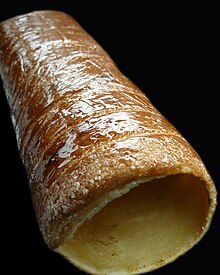Tree trimmings
The Baumstriezel ( Hungarian Kürtőskalács ("chimney cake ") , Romanian Colac secuiesc or Cozonac secuiesc , where the adjective secuiesc refers to the Szekler population group ) is a cake baked from yeast dough over (mostly) an open hearth , originating in south-eastern Transylvania .
Because of its similar shape to the Baumkuchen , the Baumstriezel (or Baumstrizel ) is usually only misleadingly called Baumkuchen . Similar pastries are the Slovak Trdelník and the Swedish Spettekaka , both of which - unlike the Baumstriezel - are protected as a designation of origin .
Manufacturing
The ingredients for tree pretzels are flour, yeast, sugar, eggs, milk, butter, salt and, as ingredients, almonds, nuts, poppy seeds, as desired. In different yeast dough recipes, around 180 grams of sugar and an equal amount of butter, eggs (around four) and 1/2 liter of milk are required for around one kilogram of flour. After about 25 minutes of kneading and slowly stirring the butter into the dough, it is allowed to rise for about half an hour. In the meantime, the “pieces of wood” on which the dough will later be turned have to be preheated.
The woods are mostly made of maple wood , as this is not too heavy, but elastic and hard, which gives the wood a smooth surface. The pieces of wood are slightly conical on the opposite side of the handle, so that the finished baked tree sticks can be removed from its baking pan more easily.
The only slightly risen dough is rolled out and wrapped in strips around the pre-lubricated molds so that the ends of the dough lie on top of each other at the edge. The strips of dough should be as thin as possible, otherwise the tree slices are unbaked and difficult to digest . You squeeze them together very lightly so that the tree truss does not dissolve into strips after baking. The Baumstiezel is coated with liquid butter and rolled in granulated sugar, to which other flavors and / or nuts can be added if desired. During baking, the baking pan is constantly turned and smeared with liquid butter again and again. In the past, it was turned by hand over / next to a fire or embers, but today the Baumstiezel is baked in different versions of fire places or electric ovens. When the treetop is glassy (because of the melted sugar) and golden brown, it is completely baked and can be removed from the mold by opening it lightly.
history
The history of the Baumstriezel is little researched and limited to little information. The origin of this cane cake is in Burzenland and the southern Szeklerland in Transylvania . Since the history of the Baumstriezel is not clear, it is considered by both the Transylvanian Saxons and the Szeklern as their traditional pastry. The Baumstriezel was the pastry for family celebrations such as baptisms , weddings , confirmations and other celebrations, where one did not shy away from the production, in order to enjoy this pastry fresh. The Kürtőskalács, which is now widespread in Hungary, is in most cases smaller than the one in Transylvania.
In 2013 the Transylvanian-Hungarian biophysicist Peter Hantz founded the International Kürtőskalács Trading Company and created documentation for the registration of the Kürtőskalács as a guaranteed traditional specialty .
Web links
- Kürtőskalács on Koch-Wiki
- heldsdorf.de: Heldsdorf's contribution to the mass production of Baumstriezel. Archived from the original on June 17, 2013 ; accessed on January 12, 2016 .
- The Kürtős cake (recipe, production, history and similar cakes) at kurtos.eu (English, Hungarian)
- Video about the production of tree stripes / Kürtőskalács on YouTube
Individual evidence
- ↑ a b Diet of the Szekler in: "Das Südostliche Ungarn", p. 279
- ^ A b Martha Liess: "Cookbook", Technischer Verlag Bucharest, 1957.
- ↑ Picture of a mechanical “tree trimming machine” at the 2008 summer festival in Rimsting
- ↑ Web presentation accessed on August 14, 2019 (English, Hungarian).
- ↑ Kürtőskalács TSG Documentation. (PDF; 304 kB) Retrieved on August 14, 2019 (English).


